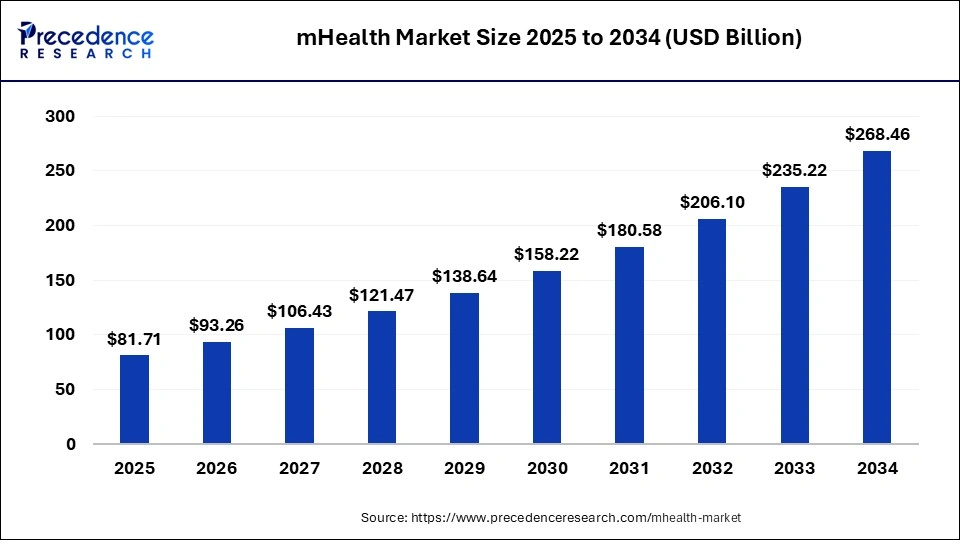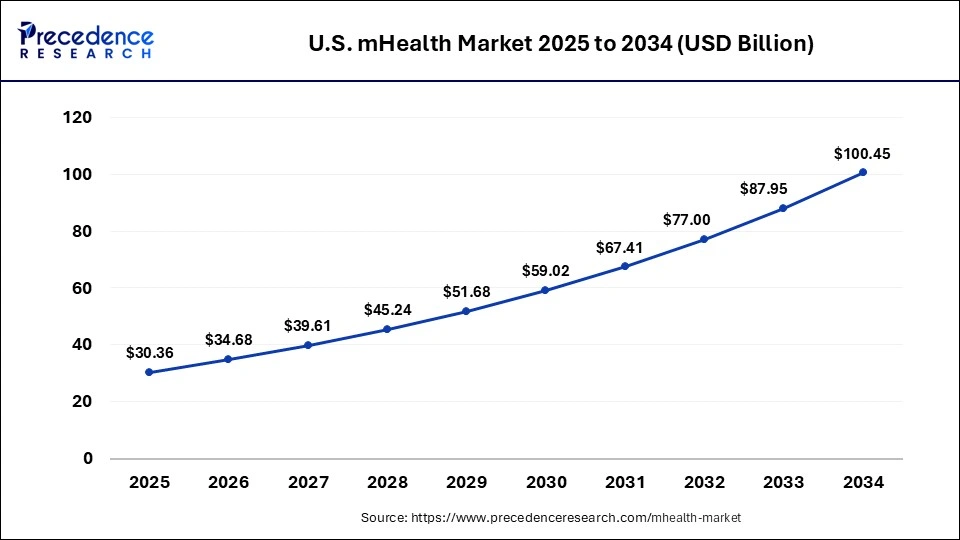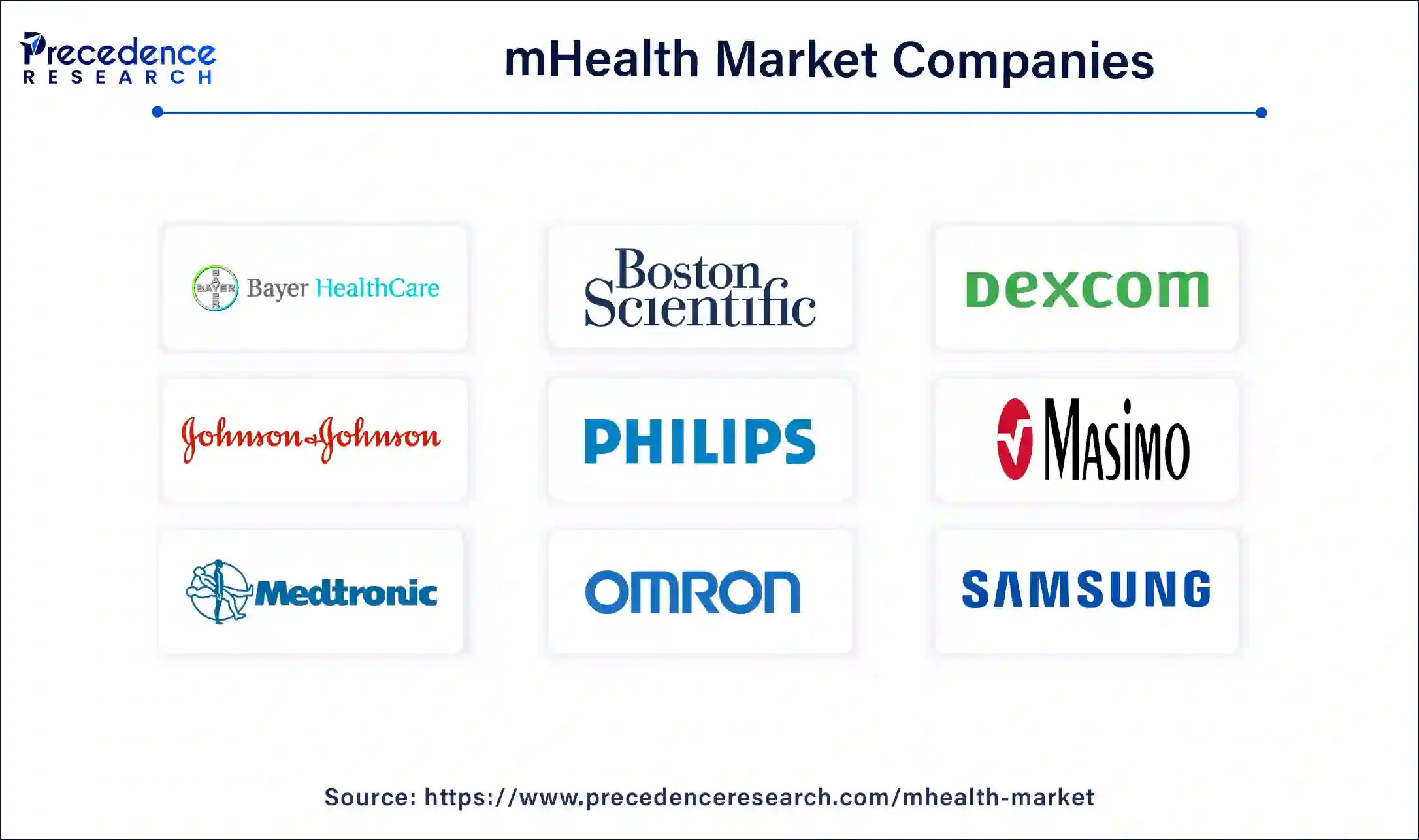List of Contents
mHealth Market Size and Forecast 2025 to 2034
The global mHealth market sizeis accounted at USD 81.71 billion in 2025 and predicted to increase from USD 93.26 billion in 2026 to approximately USD 268.46 billion by 2034, at a CAGR of 14.13% from 2025 to 2034.

mHealth Market Key Takeaways
- North America contributed a revenue share of around 38% in 2024.
- Asia Pacific region is expected to expand at the fastest CAGR of 14.8% from 2025 to 2034.
- By component, the apps segment generated more than 87% of the market revenue share in 2024.
- By services, the monitoring services segment contributed more than 63% of the market share in 2024.
AI in the Market
Artificial intelligence revolutionizes the mHealth world with personalization, diagnostics, and accessibility. AI signifies data from the wearable and connected devices in real-time while striving to compile personalized recommendations. This enhances diagnostic precision by spotting patterns in medical records. It also enables automation along administrative pathways, decreasing costs with parallel routes for improving delivery. Thus, remote monitoring and virtual consultations have expanded healthcare accessibility in remote and underserved regions. AI-personified patient engagement through personalized app content and tools for treatment adherence. It also assists in drug discovery processes by predicting the drug's efficacy and safety profiles.
U.S. mHealth Market Size and Growth 2025 to 2034
The U.S. mHealth market size was estimated at USD 26.58 billion in 2024 and is predicted to be worth around USD 100.45 billion by 2034, at a CAGR of 14.22% from 2025 to 2034.

North America dominated the global mHealth market with revenue share of 38% in 2024. The region is characterized by the growing adoption of the digital technologies in the healthcare sector, presence of sophisticated IT and telecommunication infrastructure, increased penetration of internet, and increased adoption of smartphones. Moreover, the increased prevalence of various diseases and presence of huge geriatric population has fostered the growth of the market in North America. The presence of numerous market players and their investments in the digital marketing has significantly fueled the growth of the mHealth market in the region. The increased healthcare expenditure coupled with the increased demand for the convenient healthcare services are positively impacting the market growth.

Asia Pacific is expected to be the fastest-growing region during the forecast period. This is attributable to the increasing government investments in the development of strong IT and telecommunications infrastructure. Moreover, the presence of huge youth population along with the huge social media users in the developing markets like China, India, and Indonesia is presenting lucrative growth opportunities to the market players operating in the market. Moreover, the rising consumer awareness regarding the benefits of the mHealth platforms is further expected to drive the market growth in the forthcoming future.
Europe expanded
Europe is expected to grow significantly in the mHealth market during the forecast period. Due to increasing diseases or any other health conditions in Europe, the demand for the use of mHealth is growing. At the same time, new development is also rising their demand, which promotes the market growth.
UK
The industries in the UK are developing various wearable diagnostic devices for effective monitoring of the rising diseases. At the same time, various fitness apps are also being developed. This increases the collaboration among the companies.
Germany
Increasing awareness about the well-being of health, in Germany, is leading to the use of various apps, as well as monitors for effective management of health conditions. Furthermore, new innovations are also being developed to enhance their performance.
Market Overview
mHealth, often known as mobile health, is the practice of medicine and public health that is facilitated by mobile devices such as smartphones, tablets, personal digital assistants, and wireless infrastructure. mHealth is a subset of digital health that incorporates all telecommunications and multimedia applications for the delivery of healthcare and health information. The most common digital health applications for mHealth include remote data collection, remote monitoring, education & awareness, diagnostic & treatment support, disease & epidemic outbreak tracking, healthcare worker telecommunication & training, and chronic disease management.
Several mHealth efforts around the world have proven the efficacy of employing mobile devices to deliver cost-effective health treatments.
- Patients send and receive phone calls, text messages, and voice messages about health education, treatment adherence, contacting health care providers, and arranging transportation to medical appointments.
- Healthcare professionals are given the resources they need to access the most up-to-date clinical recommendations, collaborate with colleagues, analyze data, receive diagnostic assistance, and communicate with customers.
- Positive results are accomplished by SMS alerts, which have been shown to have a greater power to affect behavior than radio and television ads. Remote data collection is possible, bridging the health information gap that many developing nations have and allowing policymakers to assess the efficacy of public health initiatives, distribute resources effectively, and optimize policies and programs.
- Smart Alert Systems, which warn clinicians via a cloud-based platform if a patient is not taking drugs as recommended and requires intervention, enhance medication adherence and chronic care management.
Furthermore, with over five billion users, mobile platforms are the most widely used technological trend on the planet. With the rising use of smartphones and the expansion of wireless network coverage, digital health systems now have new options for addressing issues such as accessibility, quality, efficacy, efficiency, and cost. As a result, the digital health community is increasingly accepting mHealth.
mHealth Market Growth Factors
The global mHealth market is driven by the rising adoption of the smartphones and improved access to the internet. According to the GSMA State of Mobile Internet Connectivity Report 2020, approximately 50% of the global population had access to the mobile internet connectivity by the end of 2019. An increase of 250 million mobile internet users was recorded from 2018 to 2019. The rising awareness regarding the internet and increasing affordability of smartphones is significantly fueling the growth of the mHealth market. Furthermore, the growing investments in the development of the telecommunications and IT infrastructure across the globe are positively impacting the mHealth market growth. According to ITU, around 4 billion people were using internet by the end of 2019. Majority of the internet users have access to the internet using smartphones. Therefore, the demand for the mHealth is directly proportional to the number of the smartphone users. Moreover, the rising awareness regarding the availability of the mHealth apps on the app store is expected to propel the growth of the market during the forecast period.
The rising prevalence of various chronic diseases among the global population and growing geriatric population are the key factors that are anticipated to drive the global mHealth market during the forecast period. According to the United Nation the global geriatric population is estimated to reach at around 2 billion by 2050. The conveniences and benefits associated with the adoption of the mHealth apps is fueling its demand. Moreover, the consultants and physicians are now increasingly adopting the mHealth platforms to reach out their patients. The patients can easily consult their physicians from the comfort of their home just at a press of a button. The favorable government regulations regarding the adoption of telehealth is fostering the growth of the mHealth industry, especially in the developed markets like North America and Europe.
- Increased smartphone penetration and better internet access all contribute to the growing adoption of mobile health platforms and applications the world over.
- Increasing numbers of chronic disease cases and their increasing elderly populations highlight the need for convenient healthcare solutions.
- Rising trusted use of digital health platforms by consultants and physicians works in favor of increased patient engagement and remote care services.
- Favorable government regulations and healthcare policies encourage the adoption of mobile health technologies in concern to both developed and developing regions.
- The telecommunications and IT infrastructure continued improvements lay a very solid foundation to provide flawless mHealth services.
Market Scope
| Report Coverage | Details |
| Market Size in 2024 | USD 71.59 Billion |
| Market Size in 2025 | USD 81.71 Billion |
| Market Size by 2034 | USD 268.46 Billion |
| Growth Rate from 2025 to 2034 | CAGR of 14.13% |
| Largest Market | North America |
| Base Year | 2024 |
| Forecast Period | 2025 to 2034 |
| Segments Covered | Component, Application, Participants, and Regions |
| Regions Covered | North America, Asia Pacific, Europe, Latin America, Middle East and Africa |
Value Chain Analysis
- Research and Development: It covers research, discovery, and drug and medical-tech development to add value through innovation and scientific progression.
Key Players: Google Inc., Apple Inc. - Clinical Trials and Regulatory Approvals: Relate to the assessment of a drug or treatment in human subjects to confirm safety and efficacy, followed by the procurement of approvals from regulatory bodies permitting the launch of such treatments into the markets.
Key Players: Parexel, Medidata - Formulation and Final Dosage Preparation: It implies those processes through which active pharmaceutical ingredients are converted to another form that is usable and stable for patients, with various dosage forms including tablets and injections.
Key Players: Ascendia, Gerresheimer AG - Packaging and Serialization: It combines functionally enclosing the drug product and furnishing it with unique identification codes so that each unit can be tracked and traced in the interests of safety, audit, and supply-chain management.
Key Players: Kezzler, Amcor plc - Distribution to Hospitals, Pharmacies: Ensure the logistical flow and final delivery of finished pharmaceutical goods to bars and pharmacies for supply to patients.
Key Players: McKesson Corporation, Cardinal Health - Patient Support and Services of mHealth: ensures post-treatment support, information, and mHealth technology integration for better patient care and treatment adherence.
Key Players: Teladoc Health, HealthSnap
Component Insights
The apps segment dominated the global mHealth market in 2024. This is attributed to the increasing number of mHealth startups and the aggressive marketing through the digital channels. The social media played a crucial role in spreading the awareness regarding the mHealth apps that boosted the adoption in the past couple of years. With the rising penetration of internet and rising number of smartphone users, the growth of this segment is expected to gain traction in the forthcoming years. Moreover, the mHealth apps may impact the health and treatment results in a positive way. The mHealth can help to store and manage health related information and can improve patient care.
On the other hand, the wearable segment is expected to gain rapid traction in the forthcoming years. This is attributable to the rising adoption of the wearable devices among the population for fitness and health goals. The increasing popularity of various wearable products like smart watches and fit-bit is expected to drive the growth of this segment in the foreseeable future.
Services Insights
The monitoring services segment garnering market share of 63% in 2024. This is attributed to the increasing prevalence of various chronic diseases along with the rising demand for the remote patient monitoring. The growing geriatric population across the globe is further expected to drive this segment's growth significantly. The old age people are more prone to various chronic diseases and needs to be monitored regularly.
The availability of the fitness related apps is also fueling the adoption of the mHealth among the population. The rising health consciousness, growing obese population, and rising consciousness regarding the food habits is compelling the people to seek the professional advice on the mHealth applications. Hence, this segment is expected to witness a considerable growth rate during the forecast period.

mHealth Market Companies
- Bayer Healthcare
- Boston Scientific Corporation
- Dexcom, Inc.
- Johnson & Johnson
- Koninklijke Philips N.V
- Masimo Corporation
- Medtronic plc
- Omron Corporation
- Samsung Group
- Sanofi
Recent Developments
- In May 2025, the last month, 2 acquisitions were made by Strava, which is a social fitness app. The Breakaway and Runna were the apps that were acquired by Strava.
- In May 2025, an announcement focusing on the improvement of comprehensive and accurate movement tracking with the use of new algorithms in the Oura Ring was made, which previously featured blood oxygen tracking and heart rate readings. The algorithm used is Real Steps, due to which Oura Ring can function more like a pedometer, and other details are also being released.
- In May 2025, home blood pressure monitors were announced by OMRON Healthcare, which include AI-powered detection of atrial fibrillation. With the use of this new novel machine learning IntelliSensetm AFib algorithm, the detection of risks, such as high stroke and heart failure, can be identified by checking AFib during every blood pressure measurement.
Segments Covered in the Report
By Component
- Apps
- Medical Apps
- Women's Health
- Personal Health Record Apps
- Medication Management Apps
- Disease Management Apps
- Diagnostic Apps
- Remote Monitoring Apps
- Others
- Fitness Apps
- Exercise & Fitness
- Diet & Nutrition
- Lifestyle & Stress
- Medical Apps
- Wearables
- BP Monitors
- Glucose Meters
- Pulse Oximeters
- Sleep Apnea Monitors (PSG)
- Neurological Monitors
- Activity Trackers/ Actigraphs
By Application
- Diagnosis
- Monitoring
- Independent Aging Solutions
- Chronic Disease Management & Post-acute Care Services
- Treatment
- Others
By Participants
- Mobile Operators
- Device Vendors
- Content Players
- Healthcare Providers
By Geography
- North America
- U.S.
- Canada
- Europe
- U.K.
- Germany
- France
- Asia Pacific
- China
- India
- Japan
- South Korea
- Rest of the World
For inquiries regarding discounts, bulk purchases, or customization requests, please contact us at sales@precedenceresearch.com
Frequently Asked Questions
Ask For Sample
No cookie-cutter, only authentic analysis – take the 1st step to become a Precedence Research client
 sales@precedenceresearch.com
sales@precedenceresearch.com
 +1 804 441 9344
+1 804 441 9344